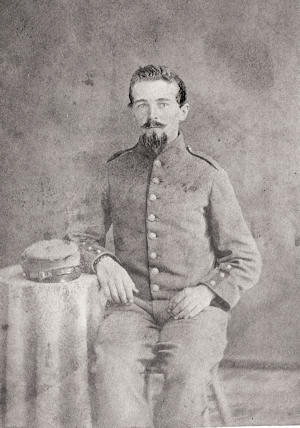| Pvt. Abner Gunsolus | Company B Fourth Wisconsin Cavalry |
Civil War Soldier from Rutland Wisconsin. Abner Gunsolus son of John Lewis Gunsolus and Evaline Hart Gunsolus. My great great uncle Abner Gunsolus 1839 to 1862 from Rutland, Dane county, Wisconsin died in the Civil War.
I spent the week-end at a Gunsolus family reunion in Minnesota. Luckily a cousin, Marlyn Westhoff, had a treasure trove of family history and photos and shared them with me. I am so lucky her branch of the family saved everything. I have another whole box of pictures to view. Here is a little history of Uncle Abner.
 Abner Gunsolus was a Private in Company B Fourth Wisconsin Cavalry 4 WIS CAV. His brother (Martin Van Buren Gunsolus’s History lists Abner killed at Ship’s Island.) Abner was in the 4th Wisconsin Cavalry. The Fourth Wisconsin Cavalry was organized as the 4th Wisconsin Infantry Regiment at Camp Utley, Racine, WI, and mustered into the service of the United States on the July 2nd, 1861.
Abner Gunsolus was a Private in Company B Fourth Wisconsin Cavalry 4 WIS CAV. His brother (Martin Van Buren Gunsolus’s History lists Abner killed at Ship’s Island.) Abner was in the 4th Wisconsin Cavalry. The Fourth Wisconsin Cavalry was organized as the 4th Wisconsin Infantry Regiment at Camp Utley, Racine, WI, and mustered into the service of the United States on the July 2nd, 1861.
It left the state on the 15th of July, proceeding to Baltimore, MD, and into camp at the Relay House, MD, August 5, 1861, remaining on duty there until early in November when the regiment was transferred to Baltimore. It remained there until the latter part of February, 1862, when it proceeded to Newport News, VA, from which point the Fourth embarked on the 6th of March to join the “Army of the Gulf.” It arrived at Ship Island below New Orleans March 12, 1862, and landed in New Orleans on May 1st.
It was at once assigned to active service and took part with an expedition up the Mississippi River against Vicksburg in May, and another in June, and with this force occupied Baton Rouge, LA, a little later in the year. The forces there were employed in successful expeditions during that winter, and in May were collected with a view of capturing Port Hudson, LA, in which siege and sanguinary contest the Fourth participated May 21 to July 8,1863. This was the last service of the Fourth as a regiment of Infantry.
On the 1st of September, 1863, the regiment was by order of the War Department equipped as a cavalry regiment. Thereafter the Fourth regiment was actively and almost constantly engaged in scouting, picketing and accompanying expeditions of various points in Louisiana and Mississippi until July, 1865, when with other troops it was transferred to Texas near the Rio Grande. Companies of the regiment were detached to guard different points along the line of that river, and the whole command remained in this service until the latter part of May, 1866, when the regiment was transferred to Madison, WI, which place was reached June 14th and the regiment was soon thereafter mustered out of service of the United States and disbanded. Source: Wisconsin Veterans Museum.
From “Mississippi History Now” Union Soldiers on Ship Island During the Civil War By James G. Hollandsworth Jr. “The wretched condition of Ship Island, a barren, desolate sand-spit, left free for the most part to alligators and such reptiles as abound in the swamps and lagoons of that region; the painful and variable climate; the sufferings of the men from diarrhea, influenza, and rheumatism; the badness of the food, which was of salt meat (no fresh meat being issued); the badness of the water, and the wretched system of cooking, made the presence of the Sanitary Commission not undesirable.”
Given the rough living conditions, unhealthy climate, and boring routine, it is not surprising that most of the Union soldiers stationed on Ship Island counted the days until they would be able to leave. Except for those unfortunate black soldiers in the 74th USCT, most of the Union soldiers who spent time on Ship Island eventually got a chance to get away.
Life on Ship island for soldiers during the Civil War was a boring, uncomfortable, and often a deadly experience. Plaques mounted at the entrance to Fort Massachusetts bear mute testimony to that fact today. These plaques bear the names of 153 Confederate prisoners of war who died and were buried on Ship Island.
However, there are no plaques with the names of the 232 Union soldiers who died and were buried there as well. They were mainly from New England – Maine, Vermont, New Hampshire, and Connecticut, with a few boys from New York, Michigan, Indiana, and Wisconsin mixed in. A dozen or more black men from Louisiana who served for almost three years on that desolate stretch of sand complete the list. After the Civil War ended, Abner Gunsolus’s body was moved to Chalmette National Cemetery, Louisiana. Union Database: G Established in May 1864 as a final resting place for Union soldiers who died in Louisiana during the Civil War, the 15,000 headstones in the cemetery mark the gravesites of veterans of the Spanish-American War, World Wars I and II, and the Vietnam War. Four Americans who fought in the War of 1812 are buried here, though only one of them took part in the Battle of New Orleans. The national cemetery is located on the site of the Battle of New Orleans in 1815, next to Chalmette Battlefield.
GUNSOLUS, ABNER 99 355 PVT B 4 WI CAV CIVIL WAR FROM SHIP ISLAND, MS
Information submited by Richard Kilmer
